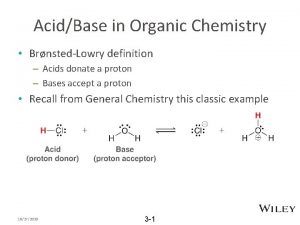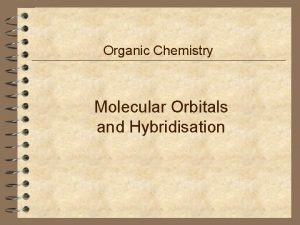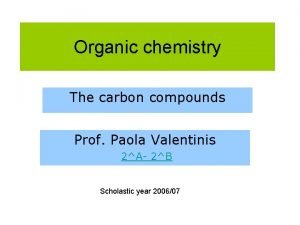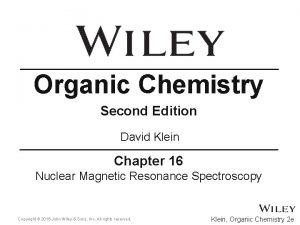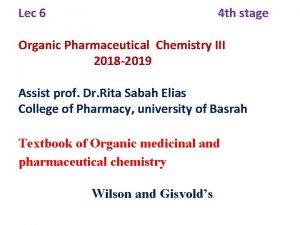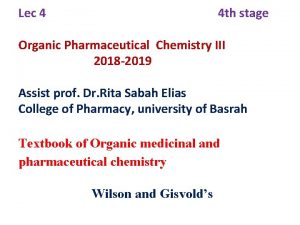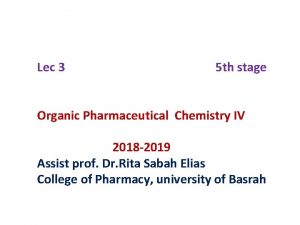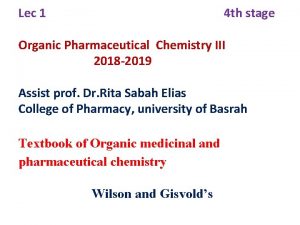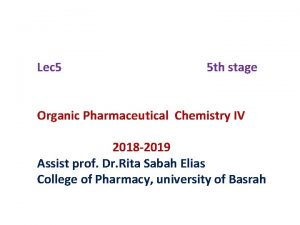Lec 3 4 th stage Organic Pharmaceutical Chemistry















- Slides: 15

Lec 3 4 th stage Organic Pharmaceutical Chemistry III 2018 -2019 Assist prof. Dr. Rita Sabah Elias College of Pharmacy, university of Basrah Textbook of Organic medicinal and pharmaceutical chemistry Wilson and Gisvold’s

SAR of penicillins

1. Modification of R to increase acid stability: If R benzyl (naturally occurring penicillin G) Penicillin G is not acid resistant it is acid sensitive. 3 reasons for the acid sensitivity of penicillin G. 1. Ring strain ( 4 membered betalactam ring + 5 membered thiazolidine ring) As a result penicillins suffers large angle and torsional strains. Acid catalyzed ring opening relieves these strains by breaking open the more highly β –lactam ring. 2. Highly reactive carbonyl group. The resonance stabilization is impossible for the β –lactam ring because of the increase in angle strain that would result in having a double bond within β –lactam ring. So the angle of the β –lactam ring constrained to 90°. So the lone pair is localized on the N atom, and the carbonyl group is more electrophilic than one would expect for a tertiary amide. 3. Influence of the acyl side chain ( has good electron character (δ-): Acyl group open up the lactam ring. So Penicillin G has a self-destruct mechanism built in its structure.

So the presence of benzyl group in penicillin G exerts: 1. 2. 3. 4. Acid labile (in vivo an in vitro) → poor oral bioavailability unless given with antacid to increase gastric p. H. Benzyl group not considered buky so it does not protect structure from penicillinase. Benzyl group considered lipophilic, so promotes activity against gram +ve organism and does not allow for optimum activity against gram –ve organism. Help promote protein binding. Note: - Benzylpenicillin is broken down by stomach acid and destroyed by staphylococcus penicillinase. So it can be given by IV.

Substitution of an electron-withdrawing group in the α position of benzylpenicillin markedly stabilizes the penicillin to acidcatalyzed hydrolysis.

1. By placing electron with drawing group in the side chain which could draw electrons away from the carbonyl oxygen and reduce its tendency to act as a nucleophile. 2. Penicillin- V has electro –ve oxygen on the acyl side chain with electron withdrawing effect. It has more acid stability than penicillin G. 3. It is more stable in acid in the stomach, so it can be given orally. 4. Infact acid sensitivity can be solved by having an electron withdrawing group on the Acyl side chain.

b- adding amino group at α-carbon→ α-aminobenzylpenicillin (ampicillin) exists as the protonated form in acidic (as well as neutral) solutions, and the ammonium group is known to be powerfully electron withdrawing.

Modification to increase penicillinase resistance increasing the steric hindrance at the α-carbon of the acyl group increased resistance to staphylococcal β-lactamase, with maximal resistance being observed with quaternary substitution.

remove α-carbon and bond the carbonyl side chain with aryl (e. g. , phenyl or naphthyl) or heteroaromatic (e. g. , 4 -isoxazoyl) system.

Substitutions at the ortho positions of a phenyl ring (e. g. , 2, 6 -dimethoxy [methicillin]) or the 2 -position of a 1 -naphthyl system (e. g. , 2 -ethoxyl [nafcillin]) increase the steric hindrance of the acyl group and confer more β-lactamase resistance than shown by the unsubstituted compounds or those substituted at positions more distant from the α-carbon. Methicillin, which has electron-donating groups (by resonance) ortho to the carbonyl carbon, is even more labile to acid-catalyzed hydrolysis than is penicillin G because of the more rapid formation of the penicillenic acid derivative.

Bulkier substituents are required to confer effective β-lactamase resistance among fivemembered-ring heterocyclic derivatives. Thus, members of the 4 -isoxazoyl penicillin family (e. g. , oxacillin, cloxacillin, and dicloxacillin) require both the 3 -aryl and 5 methyl (3 -methyl and 5 -aryl) substituents for effectiveness against β-lactamaseproducing S. aureus. The incorporation of an isoxazolyl ring in to the penicillin side chain lead to orally active compounds which were stable to β-lactamase enzymes of S. aureus. The isoxazolyl ring acts as the steric shiels but it is also electron-withdrawing, giving the structure acid stable. The βLactamase resistant penicllins tend to be comparatively lipophilic molecules that do not penetrate well into Gram –ve bacteria.

Modification of (R) to broaden spectrum of activity 1. Removal of (C-α) → ↓ G+ activity 2. Lipophilicity of R at the aryl group provides good activity against G+ microorganism and not against G- microorganism. 3. The introduction of an ionized or polar group into the α-position of the side chain benzyl carbon atom of penicillin G broaden spectrum of activity against G-ve and decrease G+ activity as seen in (C-α, COOH, NH 2, OH).

The potency of carbenicillin against most species of penicillin G-sensitive, Grampositive bacteria is lower than that of either penicillin G or ampicillin, because of poorer penetration of a more highly ionized molecule into these bacteria. (Note that α-aminobenzylpenicillins exist as zwitterions over a broad p. H range and, as such, are considerably less polar than carbenicillin. ) This increased polarity is apparently an advantage for the penetration of carbenicillin through the cell envelope of Gram-negative bacteria via porin channels. Extended spectrum of activity also achieved with derivatives of C-α such as amino group in ampicillin to amide, imidazolidinone and others.

General notes in regard stability and activity of penicillins 1. The presence of hydrogen at C-α, the antibiotic is sensitive to βlactamase. 2. The presence of electron withdrawing group at the C-α render the antibiotic stable to acidic condition and broading the spectrum of activity according to the polarity of the group and providing good oral activity. 3. Removal of C-α and bonding the carbonyl side chain directly linked to aromatic ring render the antibiotic resistance to βlactamase. 4. Lipophilic substituent on the aromatic side chain increase the activity against G+ microorganism and decreases activity against G- microorganism on the other hand polar substituent increases activity against G- microorganism.

What are the 4 classes of antibiotics? [
 Functional groups ib chemistry
Functional groups ib chemistry Organic vs inorganic chemistry
Organic vs inorganic chemistry 11th chemistry thermodynamics lec 10
11th chemistry thermodynamics lec 10 11th chemistry thermodynamics lec 13
11th chemistry thermodynamics lec 13 Indian pharmacopoeia inorganic chemistry
Indian pharmacopoeia inorganic chemistry Ario acidity
Ario acidity Organic chemistry third edition david klein
Organic chemistry third edition david klein Hybridisation
Hybridisation What is organic chemistry like
What is organic chemistry like Organic chemistry
Organic chemistry Organic chemistry
Organic chemistry Nomenclature of ethers
Nomenclature of ethers Organic chemistry
Organic chemistry Meth eth prop
Meth eth prop Chemistry of soap making
Chemistry of soap making Organic chemistry conversion chart
Organic chemistry conversion chart





